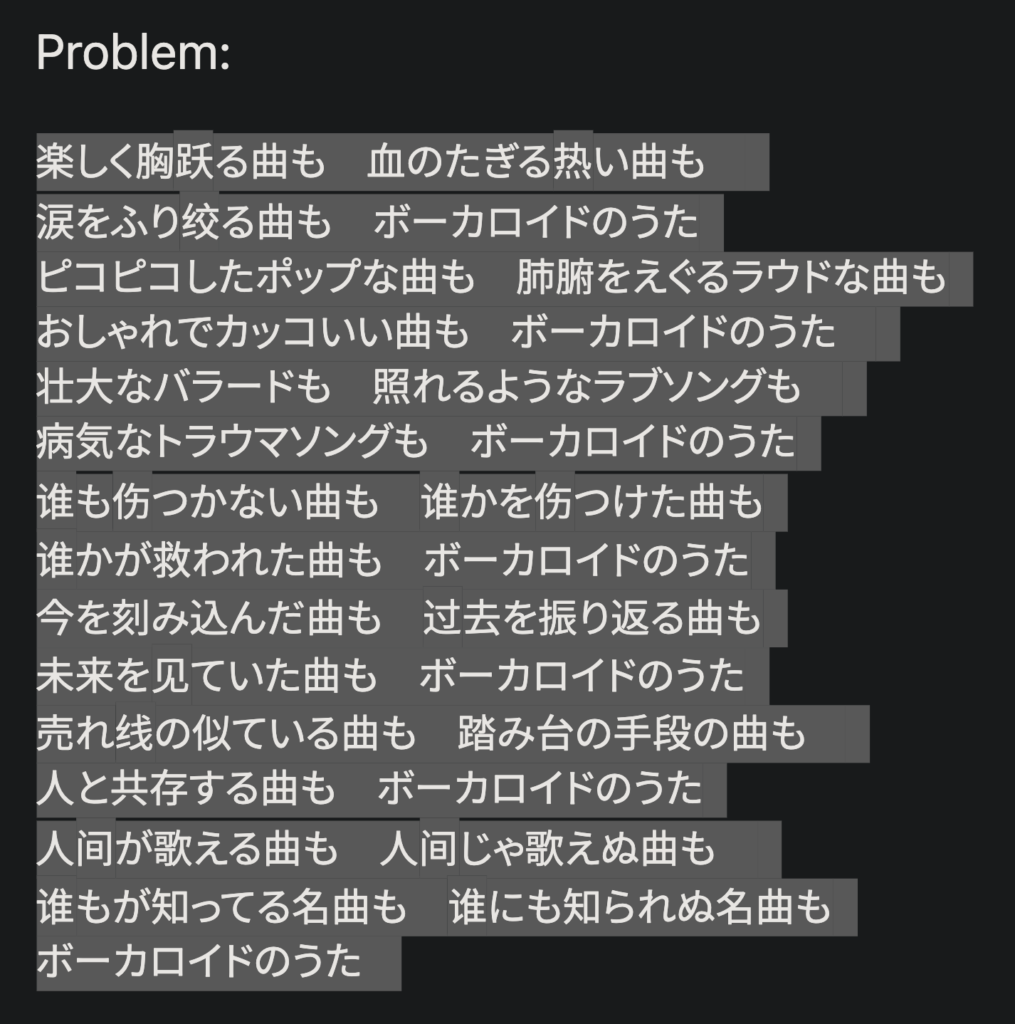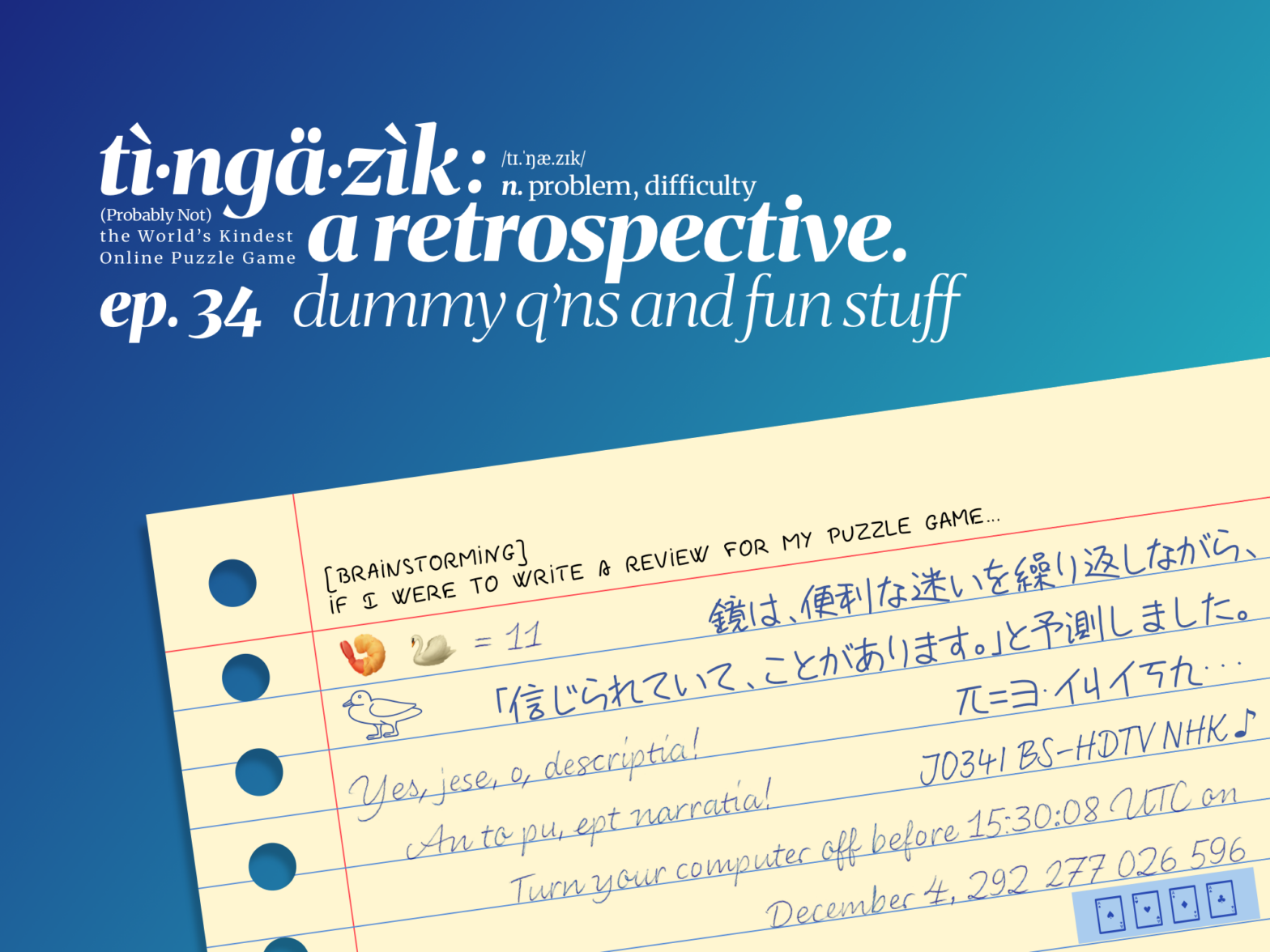Coming the the end of the retrospective series, we want to conclude with some tiny details that are dumb… and fun, I guess. (And, yeah, we finally got back our intro paragraph again. Yay!)
Dummy questions
As mentioned in episode 0, this game has included a range of dummies randomly spreaded across a range of integers and dictionary words. A lot of them was put as dummy questions as they don’t quite fit into the format of Tìngäzìk, and others are just some interesting (?) ideas for fun. One of such questions was discovered by the first challengers’ team. In this article, I’ll be going through the backgrounds of each dummy questions used in the game.
(Questions are introduced in the order of creation.)
235
This is some short pre-ads riddles taken from an episode of Tōdaiō. The filename squeezed in between the boxes is a partially hidden version of 【东大王】20200226_日字-av91955836.mp4, where the second half is the video ID of an upload of this episode on Bilibili1, and the first half being the title of the video.
Questions in these slides are in a format where the white text are the questions, and the colored texts are choices for the answer.
To solve the first question, you convert the number into Katakana English, and then take the first letter of each number. So, 4-9 becomes フォー-ナイン, then ふな (Carassius), and 3-6 would be スリー-ナイン, then すな (sand).
For the second question, all words to the left has a music note in it:
- ド(do)ライヤー = dryer
- 冷蔵庫 = れ(re)いぞうこ = fridge
- ミ(mi)シン = sewing machine
- ?
- 掃除機 = そ(so)うじき = vacuum cleaner
- ラ(ra)ジオ = radio
- C(si)Dプレーヤー = CD player
Among the choices, only ファンヒーター = fan heater has the letter “fa”.
The third question is asking plainly for “which peninsula is located in Japan”. A simple factual question. The answer is 向津具(むかつく)半島.
The last question, 🍤🦢 is tempura and swan. “Tempura swan” sounds like “ten plus one” in Japanese, so the answer is 10 + 1 = 11.
This did not become a main stage because the answer would be too easy to guess.
131
A verse from ボーカロイドの歌 by ピノキオピー with some Hànzì swapped for their Simplified Chinese version (and labeled in HTML). If you have set different default typefaces for Japanese and Simplified Chinese in your browser, you might be able to see some difference on the highlight when you select the lyrics.

This is an attempt to criticize the act of some Chinese website attempt to convert any Traditional Chinese text automatically into Simplified ones, which has led to the spread of weird Japanese text like above. And that – is a problem.
79
Mojibake is a common problem when dealing with texts in different encodings. This piece of text is encoded in UTF-8 but interpreted in Shift-JIS. The content is taken from a verse of “最高速度分離の歌(初音ミクの消失再翻訳)”.
236, 421
This 2 pages came together forms a puzzle I made over a decade ago. I hid a few prints of these 2 pages in my school like a treasure hunt. Unfortunately even right before my graduate, those pieces of papers are still sitting there untouch, and I have already forgot how I made them now. The best I can recall was that the first layer has something to do with Enigma machine and QR code. I have also tried to solve it on my own, but had no luck.
229233
This is simply how Microsoft, Apple and Google count in the names for their Windows, iPhone and Pixel product series.
2021, 21145, 314793
These are some quizzes made by QuizKnock and Capriccio in their videos [1, 2, 3] where the players are given the omitted part of abbreviations, and asked to answer the abbreviation per se. For example, when given “ly-puter”, answer “Famicom”.
Here is the list of acronyms used in the videos:
| 天(下)一(品) | Tenkaippin Ramen |
| 東(京)大(学) | University of Tokyo |
| 育(児)休(暇) | Parental leave |
| あけ(まして)おめ(でとう) | Happy New Year |
| 図(画)工(作) | Arts and Crafts |
| ミス(ター)チル(ドレン) | Mr. Children |
| 経(世)済(民) | Economy |
| ファミ(リー)マ(ート) | FamilyMart |
| (ヨコ)ハマスタ(ジアム) | Yokohama Stadium |
| 寒(ザラシトコロ)天 | Agar |
| ダブ(ルー)チ(ズバーガー) | Double Cheezeburger |
| CoCo壱(番屋) | CoCo Ichibanya |
| シャー(プ)ペン(シル) | |
| ブラ(ッド)ピ(ット) | Brad Pitt |
| 前(田)健(太) | Maeda Kenta |
| ハリ(ー)ポ(ッ)タ(ー) | Harry Potter |
| 教科(用図)書 | Textbook |
| マリ(オ)カー(ト) | Mario Kart |
| ベイ(クド)チー(ズケーキ) | Baked Cheesecake |
| ファミ(リー)レス(トラン) | Family Restaurant |
| ミス(ター)ド(ーナツ) | Mister Donut |
| 国(際)連(合) | United Nations |
| ず(っ)と真夜(中でいいのに) | Zutto Mayonaka de Iinoni |
| (焼)酎ハイ(ボール) | Chūhai |
| 携帯(電話) | Mobile phone |
| るろ(うに)剣(心) | Rurouni Kenshin |
| ナイ(ンティ)ナイ(ン) | Ninety-nine (owarai) |
| パ(ー)リ(ー)ピ(ーポー) | Party people |
533699
A bunch of birds found in the Unicode block of Hieroglyphs.
“official”
Some random text that resembles other characters but has different meanings.
| ㄫ | U+312B BOPOMOFO LETTER NG | π |
| ゠ | U+30A0 KATAKANA-HIRAGANA DOUBLE HYPHEN | equals |
| ヨ | U+30E8 KATAKANA LETTER YO | 3 |
| ・ | U+30FB KATAKANA MIDDLE DOT | point |
| イ | U+30A4 KATAKANA LETTER I | 1 |
| ㄐ | U+3110 BOPOMOFO LETTER J | 4 |
| イ | U+30A4 KATAKANA LETTER I | 1 |
| ㄎ | U+310E BOPOMOFO LETTER K | 5 |
| 九 | U+4E5D <CJK Ideograph> | 9 |
| ㄒ | U+3112 BOPOMOFO LETTER X | T |
| ㄩ | U+3129 BOPOMOFO LETTER IU | U |
| メ | U+30E1 KATAKANA LETTER ME | X |
| 🐧 | U+1F427 PENGUIN | Tux |
| 《 | U+300A LEFT DOUBLE ANGLE BRACKET | << |
| 〈 | U+3008 LEFT ANGLE BRACKET | < |
| ㄑ | U+3111 BOPOMOFO LETTER Q | < |
| く | U+304F HIRAGANA LETTER KU | < |
| ㄍ | U+310D BOPOMOFO LETTER G | << |
| < | U+FF1C FULLWIDTH LESS-THAN SIGN | < |
| フ | U+30D5 KATAKANA LETTER HU | 7 |
| ロ | U+30ED KATAKANA LETTER RO | 0 |
| ㄪ | U+312A BOPOMOFO LETTER V | 万 (10k) |
| ハ | U+30CF KATAKANA LETTER HA | 八 (8) |
| ニ | U+30CB KATAKANA LETTER NI | 二 (2) |
| ヨ | U+30E8 KATAKANA LETTER YO | 3 |
| ㄎ | U+310E BOPOMOFO LETTER K | 5 |
The text itself doesn’t have any specific meaning.
“silk”
A list of full names of TLAs that can also be written as a color code.
“abstract”
A video of the call sign of the Hi-Vision experimental broadcast of NHK.
“safari”
A screen in the song 1925 by とみー (T-Pocket) that features the word “hello” in different languages. This page is also properly notated with the language codes.
“genetic”
A mapping of non-Japanese lyrics in Vocaloid songs to – yet again – VocaDB song IDs. This was initially an alternative idea to the “cosMo” stage.
| Lyrics | Song |
|---|---|
| Sky arrow | アスノヨゾラ哨戒班 / Orangestar feat. IA |
| Fly to the moon | 三日月ライダー / 40mP feat. 初音ミク |
| Out of the gravity | 1/6 -out of the gravity- / ぼーかりおどP feat. 初音ミク |
| ICBM | 千本桜 / 黒うさP feat. 初音ミク |
| Big pale blue juice | ぽっぴっぽー / ラマーズP feat. 初音ミク |
| Find a reason to sing | Connecting / halyosy feat. KAITO, MEIKO, 初音ミク, 巡音ルカ, 鏡音リン, 鏡音レン |
| MIKU.H08152 | 初音ミクの分裂→破壊 cosMo feat. 初音ミク and Append |
| Yes, jese, o, descriptia! An to pu, ept narratia | こうして僕、幸せが生まれた / ほのづき feat. 初音ミク |
| Aglaophonos sings | 谺、碧海、那由多を見定むアグラフォノスの詩篇 / Neru, ざうに feat. GUMI |
| Nyanyanyanya nyanyanyanya nyanyanya nya nyanyanya nyanya | Nyanyanyanyanyanyanya! / daniwell feat. 初音ミク |
“action”
A piece of text written in Nüshu in the Noto Sans Nüshu typeface. The text is the first line of the Thousand Character Classic, “天地玄黄 宇宙洪荒”.
“network”
A card in the board game We Didn’t Playtest This at All mentioning the infamous Comic Sans, and its localized version in Japanese and Chinese, which are using equally abused typefaces HG Soei Kaku Poptai and PMingLiU respectively. If you have those typefaces installed on your device, these lines would also show up with the right font respectively.
“background”
A list of typefaces introduced in the recent move of Microsoft seeking opinion of the public on the next default font for their Office suite. Again, if you have these typefaces installed on your device they will show up in the correct font.
“fan”
A sticker inspired by the Best Buy Y2K Sticker and and a remake by geekenspiel on eBay for the Year 2038 Problem. The sticker on the page shows the date and time when we will run out of Unix Timestamp using a signed 64-bit integer.
Typeface used: Futura Bold
“integrity”
A quote from the song ディストピア・ジパング by cosMo@暴走P. This quote also appeared on one of my wallpapers.
“solve”
A meme-like take to write a recent mathematical discovery like a primary school holiday homework.
\begin{align*}
1^3+1^3+1^3&=3\\
4^3+4^3+(-5)^3&=3\\
\Box^3+\Box^3+\Box^3&=3
\end{align*}The question shows 2 equations of the sum of three cubes equals to three, and asking for one more. In 2020, mathematician Bagis found a third set of integers satisfy this equation:
\begin{align*}569\,936\,821\,221\,962\,380\,720^3&\ + \\(-569\,936\,821\,113\,563\,493\,509)^3&\ +\\
(-472\,715\,493\,453\,327\,032)^3&= 3
\end{align*}Trivia
Typefaces used
Logo:
Merriweather (144pt SemiExpanded Black Italics modified, 12pt SemiExpanded Black Italics, 12pt SemiExpanded Regular),
Noto Serif (SemiCondensed),
Source Han Serif SC (SemiBold),
Source Han Sans (SemiBold),
Source Han Serif (Medium).
Retrospective blog posts banner:
Pecita (Book),
LiebeHeide (Color),
851tegakizatsu (Regular),
Adobe Handwriting (Frank, Tiffany).
Stuff in the banners
- Since episode 1, the list in the banner shows the bullet point of the following posts in a modified Caesar Cipher, with the next item shifting 1 position, the one after it shifting 2 position and so on:
- alphabets rotate in three sets: QWFPGJLUY, ARSTDHNEIO, ZXCVBKM (which is the Colemak keyboard layout);
- numbers rotate on their own: 0123456789;
- punctuations never change;
- all other characters rotate within the entire Unicode.
- In ep. 21, the phrase “あぁ、夏を今もう一回!” appeared in the song Henceforth.
- In ep. 22, the lines “’awlo mune lu mune, melo mune lu tsìng, melo pxey lu pukap, pelo pxey lu volaw…” means “one two is two, two twos are four, two threes are six, three threes are nine…” in Na’vi.
- In ep. 23, the lines ”kawkrr tayìng ngati laporu, kawkrr leykayu ngati keftxo” means “Never gonna give you up, never gonna let you down” in Na’vi, which makes ep. 23 “rickroll #2”.
- Banner for ep. 26 features the poptart cat which was commonly referred as the Nyan Cat, and the OG Nyanyanyanyanyanyayan! cat.
- In ep. 32, the line “音階の取得 進化の発散 「0」から生まれる 紡ぎだすチカラ” is in the lyrics of 0 by cosMo@暴走P. This line also had the tone besides, but different from the others mentioned in the episode, this line has 2 different series of tones.
- In ep. 33, the words at the corner reads “Chūyīn Tiãndì Kāipì Shénhuà” which is the Mandarin pronunciation of 初音天地開闢神話, a song of cosMo@暴走P.
- Banners of hapxi. °26 (ep. 22) and hapxi. °27 (ep. 23) are written in Na’vi.
- Banner of lafadora. fafare-resolsol (ep. 24) is written in Solresol shorthands.
With this post, we can finally conclude the longest running series of posts on my blog. Thank you so much for following along. Thanks my friends Yan Jin, GZ Time, asfr, 天鹏 and Flying Sky for showing their interesting in beta testing the game. Thanks to COL, 血纹21, GZTime, Kizurin, Fivero, Golden, and Musicraft for your brave attempt and blazing fast speed solving the game.
Thank you, the readers, for your continuous interest in Tìngäzìk.
Hope to see you at the next work of 1A23 Studio.
- Which is a good place to find Japanese variety shows, shh!![↩]


Leave a Reply